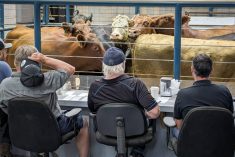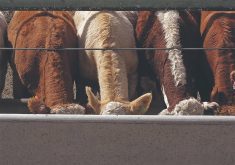Feeder cattle prices in Western Canada were steady to $2 lower last week on light volumes and limited buying interest. Feedlot demand remains sluggish as feedyard managers struggle with inefficient weight gains, higher death loss and adverse pen conditions.
The market is experiencing sharp discrepancies across Western Canada with similar cattle varying by $5-$8 per hundredweight (cwt) after adjusting for freight spreads to southern Alberta. This is a sign of extremely weak demand as buyers usually arbitrage prices very efficiently. Excessive rains are forecasted to weigh on the feeder market over the next three weeks.
Read Also

U.S. grains: Wheat recovers on short covering, soy continues to fall
Chicago | Reuters – Chicago wheat futures found their footing on Thursday on short covering but remained near eight-week lows…
Cow-calf producers in the southern regions of Western Canada have also endured higher death loss rates which will result in lower feeder cattle supplies this fall. Buying interest for replacement heifers has deteriorated, given the swamplike conditions in Manitoba and eastern Saskatchewan. The expansionary process has slowed for the time being.
Cattle producers in the U.S. southern Plains continue to liquidate cows and market lightweight calves earlier than normal. Producers in the western and northern regions appeared to be expanding herds earlier in the year; however, these U.S. ranchers are now contending with conditions similar to Western Canada’s. The U.S. cattle herd may also be smaller than expected on subsequent inventory reports.
The cattle complex is facing a major risk that the U.S. economy slips back into recession in the latter half of 2011. Lower retail spending, softer consumer confidence and rising unemployment do not bode well for restaurant traffic longer-term. Average consumer disposable income is declining with historical high gas prices and rising inflation.
— Jerry Klassen is a commodity market analyst in Winnipeg and maintains an interest in the family feedlot in southern Alberta. He writes an in-depth biweekly commentary, Canadian Feedlot and Cattle Market Analysis, for feedlot operators in Canada. He can be reached by email at [email protected] or at 204-287-8268 for questions or comments.















